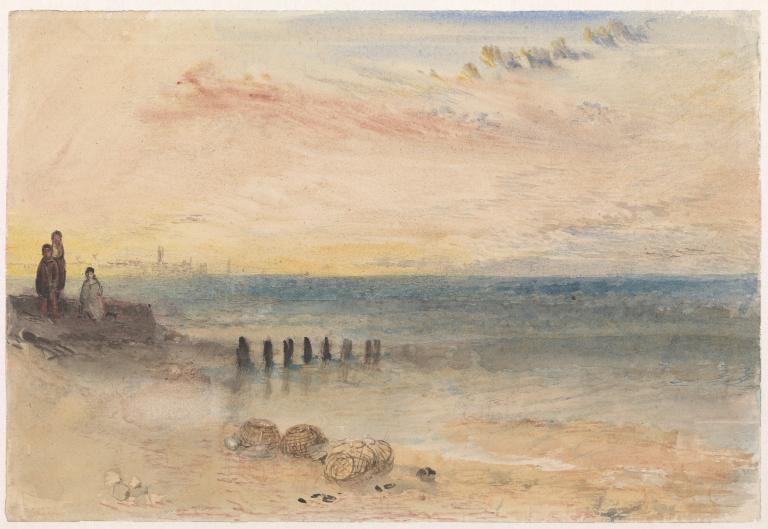Joseph Mallord William Turner A Distant View of Margate after Sunset c.1840
Joseph Mallord William Turner,
A Distant View of Margate after Sunset
c.1840
Joseph Mallord William Turner 1775–1851
A Distant View of Margate after Sunset c.1840
N05239
Pencil, watercolour and ink on white wove paper, 244 x 368 mm
Provenance:
...
Bequeathed by Beresford Rimington Heaton 1940
...
Bequeathed by Beresford Rimington Heaton 1940
Exhibition history
1986
Turner Exhibition, National Museum of Western Art, Tokyo, August–October 1986, Municipal Museum of Art, Kyoto, October–November 1986 (96, as ‘Yarmouth, from near the Harbour’s Mouth’, c.1840, reproduced in colour).
1993
Turner: The Final Years: Watercolours 1840–1851, Tate Gallery, February–May 1993 (2, as ‘Yarmouth, from near the Harbour’s Mouth’, c.1840, reproduced).
2016
Turner et la Couleur / J.M.W. Turner: Adventures in Colour, Hotel de Caumont Centre d’art, Aix-en-Provence, May–September 2016, Turner Contemporary, Margate, October 2016–January 2017 (124, as ‘Vue de Margate, de loin, après le coucher du soleil’, c.1840, reproduced in colour).
References
1954
The Tate Gallery: Report of the Trustees for the Year 1 April 1953 to 31 March 1954 with a Brief Survey of the Period 1 January 1938 to 31 March 1953, London 1954, p.44 Appendix C ‘Acquisitions 1 January 1938 to 31 March 1953’, section (c) ‘British Paintings’, as ‘Coast Scene, Sunset’.
1840
Haruki Yaegashi, Martin Butlin, Evelyn Joll and others, Turner Exhibition, exhibition catalogue, National Museum of Western Art, Tokyo 1986, p.238 no.96, as ‘Yarmouth, from near the Harbour’s Mouth’, c.1840, reproduced in colour p.239.
1840
Andrew Wilton, Turner Watercolours in the Clore Gallery, London 1987, p.132 no.59, as ‘Yarmouth’, c.1840, reproduced in colour p.[133].
1840
Robert Upstone, Turner: The Final Years: Watercolours 1840–1851, exhibition catalogue, Tate Gallery, London 1993, p.34 no.2, as ‘Yarmouth, from near the Harbour’s Mouth’, c.1840, reproduced.
1840
Ian Warrell, Alexandra Loske, Joyce H. Townsend and others, Turner et la Couleur, exhibition catalogue, Hotel de Caumont Centre d’art Aix-en-Provence 2016, p.159 no.124, as ‘Vue de Margate, de loin, après le coucher du soleil’, c.1840, reproduced in colour.
This evocative but slightly unresolved composition was acquired by Tate as ‘Coast Scene, Sunset’,1 and exhibited in 1986 and 1993 as ‘Yarmouth, from near the Harbour’s Mouth’.2 This association with Great Yarmouth in Norfolk was presumably by comparison with several works in other collection noted by Andrew Wilton as ‘traditionally known as Yarmouth subjects’ and dated to about 1840;3 see in particular a sunset subject of the same size in the National Gallery of Ireland, Dublin,4 now known as Ostend Harbour.5 However, it is ‘not known for certain that Turner visited Yarmouth after ... 1824’,6 and Ostend has been suggested as the subject of some of them in recent years. Robert Upstone7 has compared the melancholy mood of the present design, where three doll-like figures forlornly survey a cluster of beached lobster pots beside a decayed breakwater, with the watercolour Dawn after the Wreck of about 1841 (Courtauld Galleries, London),8 with its howling dog on a deserted beach under a crescent moon, and the 1840 painting of squabbling children on the beach at Margate, The New Moon; or, ‘I’ve lost My Boat, You shan’t have Your Hoop’ (Tate N00526).9
Although Upstone characterised the present work as ‘primarily a bravura account of the beautiful colours and effects of sunset rather than a topographical record’,10 Ian Warrell has since identified its setting as Margate at dusk.11 The slight indications on the horizon do indeed appear to represent the tall tower of Holy Trinity Church, which then overlooked the town, the lighthouse at the western end of the pier (perhaps with Droit House in between at the landward end), and possibly even Jarvis’s Landing Place running out into the sea. The clearer but still inconspicuous depiction of Margate’s landmarks in The New Moon was seemingly less vital to the artist than the evocation of transient atmosphere, and the same applies here.
The relatively ‘finished, yet not complete state’ of this work ‘suggests that Turner might have intended it for sale’,12 and it evidently left his studio towards the end of his life or shortly afterwards, but its early history and provenance awaits further research into its known previous owner, Beresford Rimington Heaton. A Yorkshire solicitor born in Leeds in 1863,13 he bequeathed it to the Tate Gallery in 1940 along with seven other watercolours by Turner (Tate N05236–N05238, N05240–N05243), and Pre-Raphaelite works by Dante Gabriel Rossetti and Arthur Hughes (Tate N05228–N05235, N05244–N05245).14
Matthew Imms
August 2016
Andrew Wilton, J.M.W. Turner: His Life and Work, Fribourg 1979, p.468: pp.468–9 nos.468–10, all but the last reproduced; the present work does not feature among them or elsewhere in Wilton’s listing of Turner’s watercolours.
See concise entry, National Gallery of Ireland, accessed 18 August 2016, http://onlinecollection.nationalgallery.ie/view/objects/asitem/People@2645/26 .
See ‘Person Page – 55502’, The Peerage, accessed 18 August 2016, http://www.thepeerage.com/p55502.htm , and ‘Beresford Rimington Heaton, solicitor, deeds and papers relating to property, mainly in Leeds and Harrogate’, The National Archives, accessed 18 August 2016, http://discovery.nationalarchives.gov.uk/details/rd/e9cb0165-19c9-46ea-947c-3881174a766d .
How to cite
Matthew Imms, ‘A Distant View of Margate after Sunset c.1840 by Joseph Mallord William Turner’, catalogue entry, August 2016, in David Blayney Brown (ed.), J.M.W. Turner: Sketchbooks, Drawings and Watercolours, Tate Research Publication, December 2016, https://www

